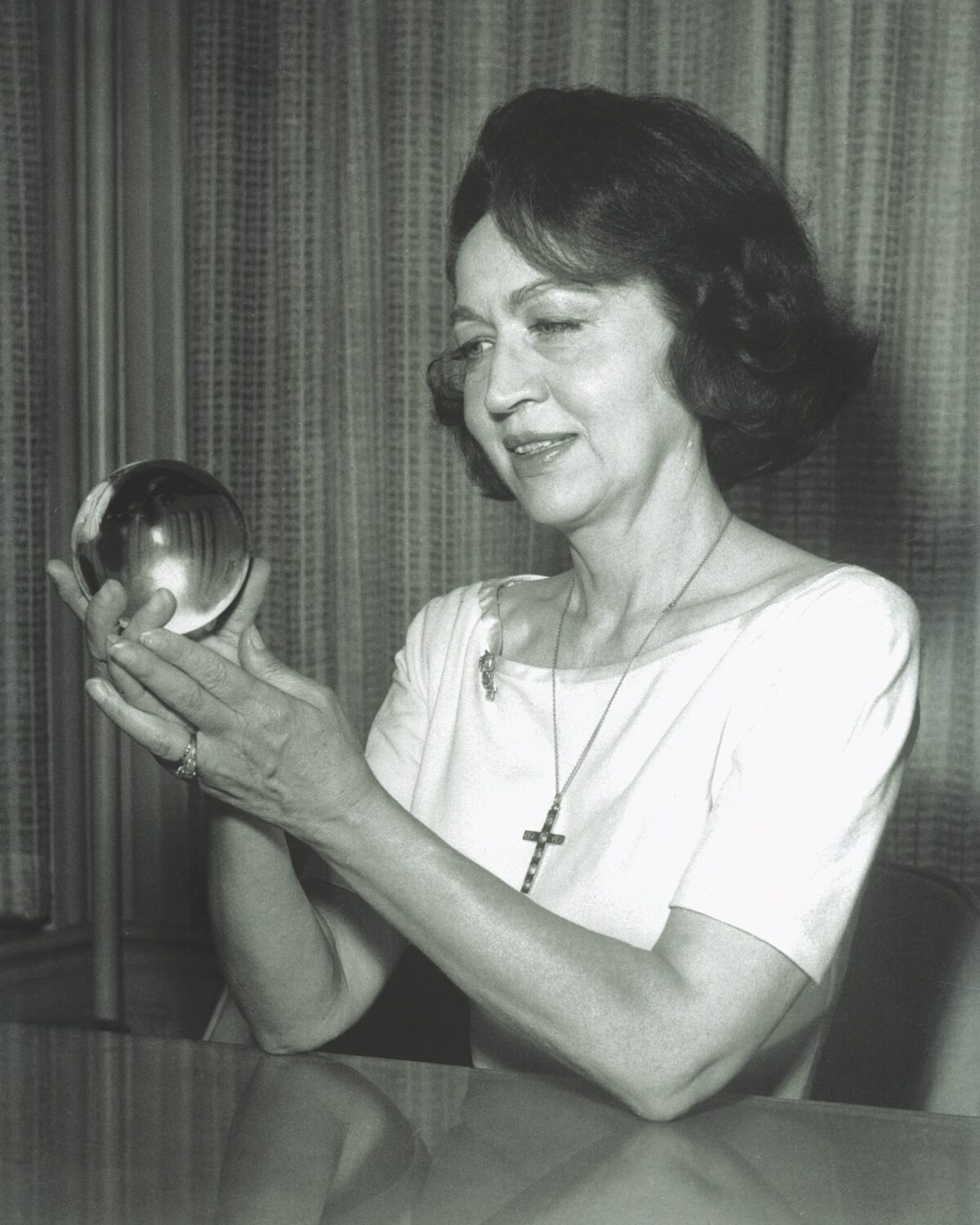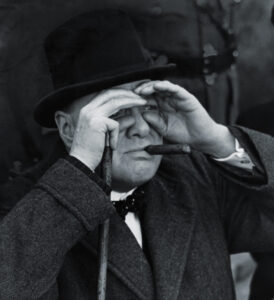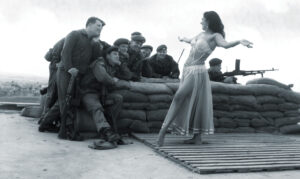Winston Churchill
Sir Winston Churchill, best known as the prime minister of the United Kingdom during World War II, clearly had the gift of prescience. In an article titled “Fifty Years Hence,” first published in the Canadian magazine Maclean’s in late 1931 and reprinted a year and a half later in Popular Mechanics, Churchill predicted that the accelerating evolution of technology would yield everything from wireless telephones and televisions to explosives that could “annihilate whole nations,” materials 30 times stronger than steel, and synthetic foods—lab-grown chicken breasts, for instance—that would be indistinguishable from the real thing.
Years earlier, Churchill had also foreseen that a vast conflict would soon engulf the world. In August 1911, nearly three years before World War I broke out, Churchill—at the time British home secretary—wrote a three-page memorandum for the Committee of Imperial Defence, “Military Aspects of the Continental Problem,” in which he accurately forecast a series of battlefield scenarios that would indeed come to pass. A year later, when he was serving as First Lord of the Admiralty, Churchill reiterated his prediction in a series of letters to a cousin, insisting that just “a little ill will or bad faith” could make an already dangerous political situation far worse. This prophesying may have seemed a lucky guess, of course, but Churchill was convinced of his ability to divine the future. As a schoolboy interested in a military career, he had warned a classmate of a great crisis that would one day unfold, though he added that there was no need for worry. “I shall save England and the empire,” he said.
Ferdinand Foch
In March 1918, as Germany’s Spring Offensive threatened to overwhelm Allied forces on the Western Front, General Ferdinand Foch of France was appointed supreme commander of the Allied Armies, and two months later he was given authority over troops on the Italian front. By August the Allied forces had beaten back the advancing Germans and then launched an offensive that stunned and subdued enemy troops, leading to an armistice.
Early the next year, at the Paris Peace Conference, Marshal Foch insisted that the proposed Treaty of Versailles was far too lenient with Germany. He maintained that it should be divided into independent states to prevent it from threatening its European neighbors again. The United States and Great Britain were far more charitable toward their vanquished enemy, however, and as the treaty was being signed, Foch is reported to have said: “This is not peace. It is an armistice for 20 years.” In fact, World War II started 20 years and 65 days later.
H. G. Wells
The celebrated British writer and social critic H. G. Wells is best remembered for his science fiction novels, most famously, perhaps, The War of the Worlds, published in 1898. While Wells’s alien-invasion tale has so far proved to be entirely fictitious, another of his novels, The World Set Free, accurately predicted—even encouraged the creation of—a weapon of war that radically altered the world as we know it.
First published in 1914 and subtitled “A Story of Mankind,” The World Set Free foresees the development of grenade-like “atomic bombs” that could be dropped from aircraft and continue to explode indefinitely, forever unleashing their uranium–based lethality. It seemed a far-fetched plot, but in 1932, as Irish physicist Ernest Wal-ton was splitting the atom for the first time, the Hungarian–born physicist Leó Szilard read Wells’s book and was struck by “what the liberation of atomic energy on a large scale would mean,” as he later wrote. In fact, Szilard, who would soon move to England by way of Germany and later to the United States, was instrumental in the Manhattan Project and the development of the atomic bomb.
Wells died in August 1946, almost a year to the day after the American B-29 bomber the Enola Gay dropped the first atomic bomb on Hiroshima.
Billy Mitchell
In April 1917, just days after the United States entered World War I, William “Billy” Mitchell, the chief of the Air Service for First Army, landed in Paris to study French and British aircraft and their military applications, and the following year, after leading some 1,500 Allied aircraft against German ground troops during the Battle of Saint-Mihiel, he was put in command of American air combat operations in France.
Following the war, Mitchell butted heads with higher-ups in the military by aggressively lobbying for the creation of an independent air force. In 1924, in an effort to tamp down Mitchell’s increasingly high-profile antics and irritating PR campaign, he was sent on an inspection tour of Asia and the Pacific. On his return Mitchell would be court—martialed and convicted of insubordination after he publicly accused army and navy leadership of “almost treasonable administration of the national defense” for investing in battleships rather than aircraft carriers. The high-profile trial captivated the nation, but there was a remarkable footnote to the ordeal: In the report that Mitchell submitted following his 1924 trip, he warned that a forthcoming war would include a surprise Japanese attack on Pearl Harbor, Hawaii, and the Philippines. He wrote: “Attack will be launched as follows: Bombardment, attack to be made on Ford Island (Hawaii) at 7:30 A.M.….Attack to be made on Clark Field at 10:40 A.M.” In fact, the Japanese attacked Pearl Harbor at 7:55 a.m. on December 7, 1941, and Clark Field in the Philippines at 12:35 p.m.
Mitchell died of heart problems five years before his prediction proved true. On August 8, 1946, he was posthumously awarded a Special Congressional Medal of Honor—the only one of its kind—“for outstanding pioneer service and foresight in field of American military aviation.”
Saint Joan of Arc
Jeanne d’Arc, a.k.a. The Maid of Orléans, was born to peasant farmers in 1412 in the French village of Domrémy. Her early years were steeped in prayer and religious devotion, and at age 13 she claimed to have heard—for the first of many times—the voices of saints, who instructed her to expel invading English forces from their strongholds throughout northern France and install Charles VII, the dauphin (the heir to the throne), to his rightful position.
Three years later, following an 11-day trek through enemy territory to Charles’s palace, 17-year-old Joan of Arc promised the dauphin that she would see him crowned at Reims, the traditional site of French coronations. In April 1429, with his military teetering on defeat in the Hundred Years’ War, the would-be king put Joan at the head of an army bound for Orléans, which for half a year had been under siege by English troops. A week before leaving, Joan accurately predicted that she would save Orléans (the city was freed by May 8, when the English retreated); that she would be hit by an arrow but survive (it pierced above her breast, but she soon returned to battle and inspired her troops to finish their attack); and that the 26-year-old Charles would be crowned later that summer. (The ceremony was held on July 17, a month after French forces had routed the English in the Battle of Patay, decimating the invading army.)
Joan of Arc also accurately predicted her own capture during another battle the following summer. In March 1431, two months before being convicted of heresy and burned at the stake, she prophesied that, within seven years, the English would suffer a defeat more consequential than the one at Orléans; in fact, six years and eight months later, the English lost their grip on Paris, which they had occupied for more than a decade.
Jeane Dixon
Jeane Dixon is perhaps best known for her 1956 prediction in Parade magazine that a tall, brown-haired Democrat would win the 1960 presidential election and then be “assassinated or die in office.” Dixon dished out other prophecies about the nation’s presidents (some accurate and others way off base), and a handful of them even summoned her to help them navigate matters of public policy.
Richard Nixon, for example, met with Dixon in 1971 and the following year he is said to have established the Cabinet Committee to Combat Terrorism based, in part, on her predictions of domestic attacks. In 1962 Dixon told Ronald Reagan that he was destined for the White House, and following the 1980 election First Lady Nancy Reagan asked her to help the new president with astrological readings.
The most dramatic of Dixon’s presidential encounters, however, came decades earlier. In late 1944, shortly after being elected to an unprecedented fourth term, Franklin D. Roosevelt secretly invited Dixon to the first of two Oval Office chats about military and geopolitical matters. Dixon accurately projected that World War II would end within six months or so (although FDR, as Dixon skittishly told him that day, would not live long enough to witness it). Roosevelt also asked Dixon for her take on postwar alliances, and, to his astonishment, she claimed that the Soviet Union, a wartime ally in the fight against Germany, would ultimately be a threat to the United States. At the Yalta Conference in Crimea the following February, an ailing Roosevelt dismissed Dixon’s premonitions and agreed to give the Soviets control over Eastern Germany and part of Berlin after he and British prime minister Winston Churchill extracted a pledge from Soviet premier Joseph Stalin to allow free elections throughout the defeated or liberated countries of Eastern Europe. Roosevelt died two months later, and Stalin would later break his pledge by scuttling elections and establishing communist governments in Bulgaria, Czechoslovakia, Hungary, Poland, and Romania—setting the stage for the Cold War.
But if Dixon’s crystal ball was well calibrated for her confabs with Roosevelt, not too long after that she whiffed mightily on her prediction that World War III would begin in 1958.






